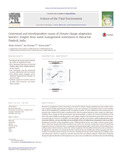JavaScript is disabled for your browser. Some features of this site may not work without it.
| dc.contributor.author | Azhoni, Adani | |
| dc.contributor.author | Holman, Ian P. | |
| dc.contributor.author | Jude, Simon R. | |
| dc.date.accessioned | 2016-11-22T10:48:23Z | |
| dc.date.available | 2016-11-22T10:48:23Z | |
| dc.date.issued | 2016-10-31 | |
| dc.identifier.citation | Azhoni A, Holman I, Jude S, Contextual and interdependent causes of climate change adaptation barriers: Insights from water management institutions in Himachal Pradesh, India, Science of the Total Environment, Volume 576, Issue January 2017, pp. 817-828 | en_UK |
| dc.identifier.issn | 0048-9697 | |
| dc.identifier.uri | http://dx.doi.org/10.1016/j.scitotenv.2016.10.151 | |
| dc.identifier.uri | http://dspace.lib.cranfield.ac.uk/handle/1826/10997 | |
| dc.description.abstract | Research on adaptation barriers is increasing as the need for climate change adaptation becomes evident. However, empirical studies regarding the emergence, causes and sustenance of adaptation barriers remain limited. This research identifies key contextual causes of adaptation barriers in water institutions in the mountainous Himalayan state of Himachal Pradesh in northern India. Semi-structured interviews were carried out with representatives from twenty-six key governmental, non-governmental, academic and research institutions in the State with responsibilities spanning domestic water supply, irrigation and hydropower generation, environmental monitoring and research. It identified low knowledge capacity and resources, policy implementation gaps, normative attitudes, and unavailability and inaccessibility of data and information compounded with weak interinstitutional networks as key adaptation barriers. Although these barriers are similar to those reported elsewhere, they have important locally-contextual root causes. For instance, inadequate resources result from fragmented resources allocation due to competing developmental priorities and the desire of the political leadership to please diverse electors, rather than climate scepticism. The identified individual barriers are found to be highly inter-dependent and closely intertwined which enables the identification of leverage points for interventions to maximise barrier removal. For instance, breaking down key barriers hindering accessibility to data and information, which are shaped by systemic bureaucracies and cultural attitudes, will involve attitudinal change through sensitisation to the importance of accurate and accessible data and information and the building trust between different actors, in addition to institutional structural changes through legislation and inter-institutional agreements. Approaching barriers as a system of contextually interconnected cultural, systemic, geographical and political underlying factors enriches the understanding of adaptation enablers, thereby contributing to achieving a better adapted society. | en_UK |
| dc.language.iso | en | en_UK |
| dc.publisher | Elsevier | en_UK |
| dc.rights | Attribution 4.0 International | |
| dc.rights.uri | http://creativecommons.org/licenses/by/4.0/ | |
| dc.subject | Adaptation | en_UK |
| dc.subject | Barriers | en_UK |
| dc.subject | Climate change | en_UK |
| dc.subject | Institutions | en_UK |
| dc.subject | India | en_UK |
| dc.subject | Water | en_UK |
| dc.title | Contextual and interdependent causes of climate change adaptation barriers: Insights from water management institutions in Himachal Pradesh, India | en_UK |
| dc.type | Article | en_UK |
Files in this item
This item appears in the following Collection(s)
-
Staff publications (SWEE) [2825]

